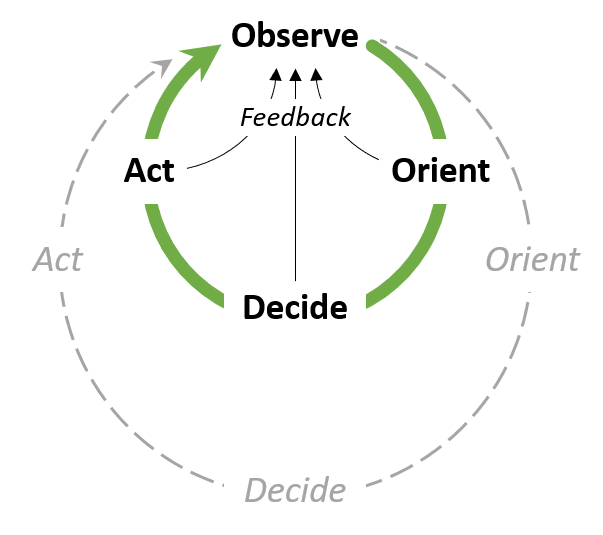In business, time to market (TTM), is very important. Late product launches and slow TTM negatively impact revenues, risk the erosion of the addressable market, reducing opportunities and causing products to become obsolete faster. That’s why, the speed and pace of the global operating environment is only getting get faster and faster. You can say there is a “terror-balance” (interdependence) between value creation, risk and speed. Eliminate all risks and, at the same, time you eliminate any value creation. Both at highest and lowest possible speed you get exposed to more risk.
For a long time in product and process development, control of compliance has been applied to manage risks. For every new mistake an additional control function is added. As an effect, development projects take longer increasing time to market, in contradiction to the need and desire, to go faster. Leaders that ear the unknowns and desire to “manage” risks usually seek control. Leaders issue orders and set-up systems to ensure compliance. They ‘Command and Control’ their subordinates and development teams.
Can we offer leaders another way, another leadership principle?
For maneuvering warfare, there is a military doctrine that is designed to both ensure speed and manage risks. A way to manage the unknowns that happen and were not possible to foresee in advance. That’s ‘Mission Command’, which originates from the German philosophy of “Auftragstaktik”. It has proven its worth for over two centuries, yet it is still a modern leadership principle.
‘Mission Command’ is a counter-approach to the ‘Command and Control’ Leadership style. Mission command empowers subordinates’ decision-making and decentralized execution appropriate to the situation. Mutual trust is a fundamental building block of this approach. In practice, leaders have to accept risk when pushing authority to subordinates to make decisions. You can say, “leaders pull risk from, and push authority to their subordinates.”
His Majesty made you a Major because he believed you would know when not to obey his orders.
What can leaders learn from ‘Mission Command’?
When applying ‘Mission Command,’ the leaders issue missions, not detailed, orders. The commander issues clear intent, so called ‘Commander’s Intent,’ and empower subordinates to take initiative. There are two parts to any mission. The task to be completed and the reason, or intent. The task describes the action to be taken. The intent describes the desired result of the action. Of the two, the intent is predominant. A situation may change, making the task obsolete, while the intent is more enduring and continues to guide actions. Subordinate teams, understanding their ‘Commander's Intent,’ can exercise initiative in harmony with the commander's desires without taking the time to go back up the chain for further approvals.

It is the leader’s responsibility to phrase short and memorable intent, describing the desired future state so that teams can act. For example, Tesla’s corporate mission is “to accelerate the world’s transition to sustainable energy” and Apple’s is “bringing the best user experience to its customers through its innovative hardware, software, and services.”
Mission Command:
- is everyone’s joint mission, the entire organization or group;
- builds upon mutual trust, through shared values and experiences of teams overcoming adversity;
- provides focus and direction, concentrating everyone’s efforts on the joint mission
- enables flexibility, initiative, freedom, and cooperation across all levels;
- radically improves teams’ intuitive skills.
The combination of joint mission, mutual trust, focus and direction, and intuitive skills creates a highly innovative and agile organization, which is much faster to adapt to rapidly changing situations in the market they serve. Who doesn’t want such a work organization, that incorporates variety, creativity, flexibility, diversity and learning communities?
Freedom of activity ensures that small teams operate autonomously, pursue opportunities and share knowledge among themselves. Unlike the traditional ‘Command and Control’ – top-down management style – used by the less agile organizations, this leadership principle of ‘Mission Command’ incorporates ‘loose-tight’ control: the shared values of the corporate culture provide tight control, while the mutual trust between managers and employees liberates staff to discover new opportunities, learn and innovate without additional approvals (loose control). Successful ‘Mission Command’ leaders foster an environment of experimentation, mistakes and uncertainty, giving room for rapid adaptation.
With the speed and pace of global operating environment getting faster and faster, initiative, and independent thought and action become critically important factors. The leadership principles and the corporate culture need to adapt. To modernize the leadership in business, there are lots of learnings to make from ‘Mission Command’ / Auftragstaktik. Businesses need the culture of ‘Mission Command’ to address these rapidly changing situations and win on any challenge.

Christer Lundh
Christer Lundh is president of AUFERO, a firm that makes organizations more profitable by improving product development and innovation. He is chairman at LPPDE.org. A passionate leader co-creating flow of new products and innovations together with clients.

